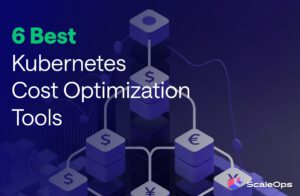As Kubernetes becomes the backbone of modern application deployment, platform engineering teams face the challenge of managing its resource complexity. While Kubernetes provides the flexibility and scalability necessary to handle containerized workloads, ensuring efficient resource management is critical for both innovation and operational efficiency. Mismanagement can lead to performance bottlenecks, higher costs, and downtime. This is where intelligent automation platforms like ScaleOps step in, dramatically simplifying resource management.
The Resource Management Challenge in Kubernetes
Managing resources in Kubernetes is complex, especially as clusters scale. Platform engineers must ensure that each application gets the right amount of CPU, memory, and storage without over- or under-provisioning. Poor configuration can lead to costly inefficiencies—over-provisioned resources that increase costs and under-provisioning that harms application performance.
Further complicating this challenge is the fact that Kubernetes is designed to be flexible. This means engineering teams have to manually adjust resource allocations, fine-tune autoscalers, and optimize workloads, which can take time and requires in-depth knowledge of Kubernetes mechanics. This can detract from innovation, pushing engineers to focus on cluster management tasks instead of building features that drive business value.
How ScaleOps Simplifies Kubernetes Resource Management
ScaleOps automates the most cumbersome aspects of Kubernetes resource management, freeing platform teams from the constant need to monitor and adjust resource allocations manually. This automation optimizes performance, enhances operational efficiency, and drives cost savings—all in real-time. Here’s how:
- Dynamic Pod Resource Requests
Instead of relying on static resource requests that require continuous tuning, ScaleOps dynamically adjusts pod resource allocations based on actual demand. This ensures applications get the right amount of resources at the right time, preventing over-allocation and under-utilization. - Automated Scaling
ScaleOps streamlines both Horizontal Pod Autoscaling (HPA) and Vertical Pod Autoscaling (VPA) to ensure your applications scale appropriately as workloads fluctuate. This not only optimizes performance but also minimizes resource wastage, preventing CPU throttling and memory overflows. - Contextual Visibility Without the Complexity
While ScaleOps handles the underlying resource allocation, it doesn’t leave product teams in the dark. With intuitive dashboards, engineers can monitor the performance and resource consumption of their applications in real-time without needing to understand the underlying complexities of Kubernetes. This visibility helps teams identify performance bottlenecks, optimize application behavior, and make data-driven decisions, all while keeping resource management abstracted away from their workflow.
Balancing Innovation and Operational Efficiency
Platform engineers play a crucial role in shielding product teams from the complexity of Kubernetes. With ScaleOps, they can provide a high-performing, resource-efficient environment while ensuring that product teams focus on what they do best—building and deploying applications that deliver business value.
Key Benefits of ScaleOps for Platform Engineering Teams:
- Reduced Operational Overhead: With automation handling pod resource requests, platform engineers no longer need to spend time on manual tuning and cluster management. This allows them to dedicate more resources to innovation and scaling the platform.
- Optimized Resource Utilization: ScaleOps continually monitors resource usage, making adjustments to ensure no resources go wasted. This leads to substantial cost savings, especially in cloud environments where resource efficiency directly translates to lower infrastructure costs.
- Improved Performance and Availability: By ensuring that resource requests are accurately tuned to real-time demand, ScaleOps minimizes performance bottlenecks, ensuring that applications remain responsive and highly available, even under varying loads.
Empowering Product Teams
Product teams, while not exposed to Kubernetes complexities, benefit greatly from the insights ScaleOps provides. The platform allows them to:
- Track Workload Behavior: Through contextualized dashboards, product teams can monitor how their applications consume resources without having to deal with the details of pod scheduling and node management.
- Data-Driven Decision Making: With access to real-time resource usage and performance metrics, product teams can make informed decisions to improve application performance and scalability.
Conclusion: Transform Your Kubernetes Platform with ScaleOps
Kubernetes resource management doesn’t have to be a constant challenge. With ScaleOps, platform engineering teams can automate the most tedious aspects of resource allocation, reducing operational overhead while ensuring clusters run efficiently. By providing both automation and visibility, ScaleOps creates an environment where both platform and product teams thrive—innovation continues unhindered while operational efficiency soars.
If you’re ready to simplify Kubernetes resource management and optimize cluster performance, ScaleOps is the solution to transform your platform engineering strategy. Experience the power of intelligent resource management today and let your teams focus on building the next big thing, not on Kubernetes complexities.
Try ScaleOps today and see how it can enhance your platform’s efficiency and productivity!























